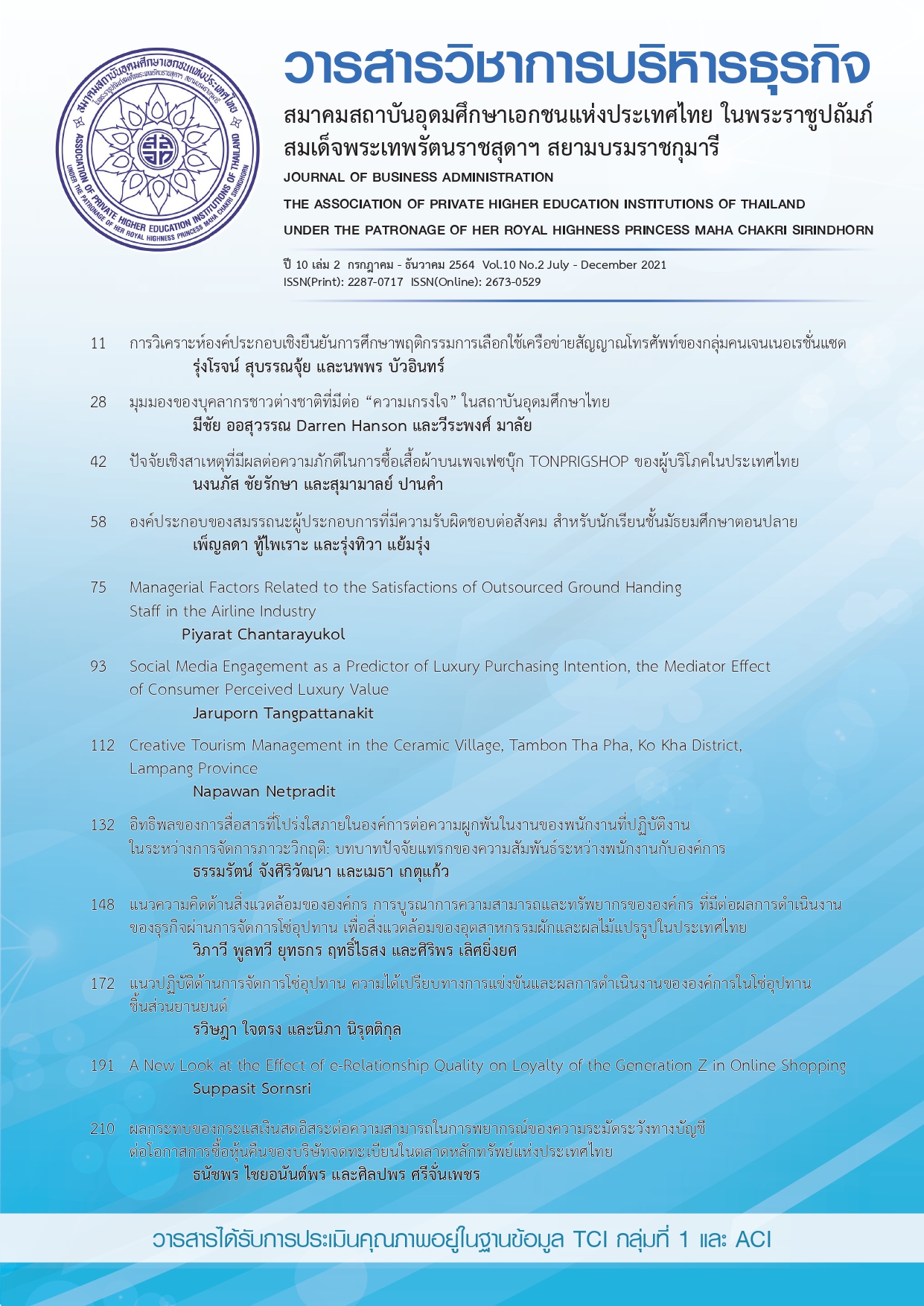แนวความคิดด้านสิ่งแวดล้อมขององค์กรการบูรณาการความสามารถและทรัพยากรขององค์กร ที่มีต่อผลการดำเนินงานของธุรกิจผ่านการจัดการโซ่อุปทานเพื่อสิ่งแวดล้อมของอุตสาหกรรมผักและผลไม้แปรรูปในประเทศไทย
คำสำคัญ:
แนวความคิดด้านสิ่งแวดล้อมขององค์กร, การบูรณาการความสามารถและทรัพยากรขององค์กร, การจัดการโซ่อุปทานเพื่อสิ่งแวดล้อม, ผลการดำเนินงานของธุรกิจ, อุตสาหกรรมผักและผลไม้แปรรูปบทคัดย่อ
การศึกษาครั้งนี้มีวัตถุประสงค์ 1) เพื่อศึกษาอิทธิพลเชิงสาเหตุของแนวความคิดด้านสิ่งแวดล้อมขององค์กร การบูรณาการความสามารถและทรัพยากรขององค์กร และการจัดการโซ่อุปทานเพื่อสิ่งแวดล้อมที่มีต่อผลการดำเนินงานของธุรกิจของอุตสาหกรรมผักและผลไม้แปรรูปในประเทศไทยและ2) เพื่อศึกษาปัญหาและแนวทางการพัฒนาการจัดการโซ่อุปทานเพื่อสิ่งแวดล้อมของอุตสาหกรรมผักและผลไม้แปรรูปในประเทศไทยซึ่งใช้วิธีการวิจัยแบบผสมวิธี โดยในการวิจัยเชิงปริมาณจะใช้แบบสอบถามเป็นเครื่องมือในการเก็บรวบรวมข้อมูลจากผู้บริหารจำนวน 214 บริษัท และทำการวิเคราะห์ข้อมูลโดยใช้แบบจำลองสมการโครงสร้างและในการวิจัยเชิงคุณภาพจะใช้แบบสัมภาษณ์เชิงลึกในการสัมภาษณ์ผู้บริหารเพื่อยืนยันผลการวิจัย และรวบรวมข้อมูลเกี่ยวกับแนวทางการพัฒนาการจัดการโซ่อุปทานเพื่อสิ่งแวดล้อม ผลการวิจัยพบว่า 1) แนวความคิดด้านสิ่งแวดล้อมขององค์กร และการบูรณาการความสามารถและทรัพยากรขององค์กรส่งผลกระทบทางตรงเชิงบวกต่อการจัดการโซ่อุปทานเพื่อสิ่งแวดล้อม 2) แนวความคิดด้านสิ่งแวดล้อมขององค์กร และการบูรณาการความสามารถและทรัพยากรขององค์กรไม่ส่งผลกระทบทางตรงต่อผลการดำเนินงานของธุรกิจ3) การจัดการโซ่อุปทานเพื่อสิ่งแวดล้อมส่งผลกระทบทางตรงเชิงบวกต่อผลการดำเนินงานของธุรกิจ และ 4) แนวความคิดด้านสิ่งแวดล้อมขององค์กร และการบูรณาการความสามารถทรัพยากรขององค์กร มีอิทธิพลทางอ้อมต่อผลการดำเนินงานของธุรกิจผ่านการจัดการโซ่อุปทานเพื่อสิ่งแวดล้อมซึ่งมีความสอดคล้องกับผลการวิจัยเชิงคุณภาพ โดยผู้บริหารสามารถนำไปประยุกต์ใช้ให้เหมาะสมกับบริบทของแต่ละองค์กร และเป็นแนวทางพัฒนาด้านการจัดการโซ่อุปทานเพื่อสิ่งแวดล้อม เพื่อนำไปสู่การยกระดับผลการดําเนินงานของธุรกิจ ได้แก่ ผลกำไร เพิ่มส่วนแบ่งทางการตลาด สร้างความได้เปรียบทางการแข่งขัน ลดต้นทุน สร้างภาพลักษณ์ที่ดีและลดผลกระทบต่อสิ่งแวดล้อม
References
Abdel-Baset, M., Chang, V., & Gamal, A. (2019). Evaluation of the green supply chain management practices: A novel neutrosophic approach. Computers in Industry, 108, 210-220.
Abdeen, F.N., & Sandananyake, Y.G. (2018). Facilities management supply chain: Function, flows and relationship. Procedia Manufacturing, 17, 1104–1111.
Abdul-Rashid, S.H., Sakundarini, N., Raja Ghazilla, R.A., & Thurasamy, R. (2017). The impact of sustainable manufacturing practices on sustainability performance: Empirical evidence from Malaysia. International Journal of Operations & Production Management, 37(2), 182-204.
Afsar, B., Badir, Y., & Kiani, U.S. (2016). Linking spiritual leadership and employee pro-environmental behavior: the influence of workplace spirituality, intrinsic motivation, and environmental passion. Journal of Environmental Psychology, 45, 79-88.
Agrawal, S., Singh, R.K., & Murtaza, Q. (2015). A literature review and perspectives in reverse logistics. Resources, Conservation and Recycling, 97, 76-92.
Ahi, P., & Searcy, C. (2015). An analysis of metrics used to measure performance in green and sustainable supply chains. Journal of Cleaner Production, 86, 360–377.
Ahmed, W., Asim, M., & Manzoor, S. (2020). Importance and challenges of green supply chain management in healthcare. EJBMR, European Journal of Business and Management Research, 5(2), 1-8.
Akintoye, A., McIntosh, G., & Fitzgerald, E. (2000). A survey of supply chain collaboration and management in the UK construction industry. European Journal of Purchasing and Supply Management, 6, 159–168.
Arseculeratne, D., & Yazdanifard, R. (2014). How green marketing can create a sustainable competitive advantage for a business. International Business Research, 7(1), 130-137.
Bahremand, M., & Karimi, R. (2016). Identify and evaluate the factors influencing technological capapilities using fuzzy dematel techniques at science and technology parks. Case study: Knowleadge-based companies at Mashhad’s science and technology park. Journal of Engineering and Applied Sciences, 11(4), 678-683.
Barney, J. B. (1991). Firm resources and sustained competitive advantage. Journal of Management, 17(1), 99-120.
Benachio, G. L. F., Freitas, M. C. D., & Tavares, S. F. (2019). Green supply chain management in the construction industry: A literature review. In IOP Conference Series: Earth and Environmental Science, 225(1), 12011.
Carvalho, L. S. D., Stefanelli, N. O., Viana, L. C., Vasconcelos, D. S. C., & Oliveira, B. G. (2020). Green supply chain management and innovation: a modern review. Management of Environment Quality: An International Journal, 31(2), 470-482.
Chen, Y., Okudan, G. E., & Riley, D. R. (2010). Sustainable performance criteria for construction method selection in concrete buildings. Automation in Construction, 19(2), 235-244.
Coyle, J. J., Thomchick, E. A., & Ruamsook, K. (2015). Environmentally sustainable supply chain management: an evolutionary framework. In Marketing Dynamism & Sustainability: Things Change, Things Stay the Same. (pp. 365-374). Springer, Cham.
Cronbach, L. J. (1970). Essentials of Psychological Test (5thed.). New York: Harper Collins. Department of International Trade Promotion, Ministry of Commerce, Thailand. (2020). Fact sheet fruit and vegetable processing industry in Thailand. Retrieved from https://ditp.go.th/ditp_web61/ article_sub_view.php?filename= contents_ attach/607169/607169.pdf&title=607169&cate=751&d=0.
Dwivedi, Y. K., Hughes, L., Ismagilova, E., Aarts, G., Coombs, C., Crick, T.,….. & Galanos, V. (2019). Artificial intelligence (AI): multidisciplinary perspectives on emerging challenges, opportunities, and agenda for research, practice and policy. International Journal of Information Management, 57, 1-47.
Eltayeb, T., & Zailani, S. (2009). Going green through green supply chain initiatives towards environmental sustainability. Operations & Supply Chain Management, 2(2), 93-110.
Fernando, Y., Bee, P.S, Jabbour, C. J. C., & Thome, A. M. T. (2018). Understanding the effects of energy management practices on renewable energy supply chains: implications for energy policy in emerging economies. Energy Policy, 118, 418-428.
Gao, Y. (2017). Business leaders’ personal values, organisational culture and market orientation. Journal of Strategic Marketing, 25(1), 49-64.
Ghobakhloo, M., Tang, S. H. N., Zulkifli, N., & Ariffin, M. K. A. (2013). An integrated framework of green supply chain management implementation. International Journal of Innovation, 4(1), 86-89.
Glavas, A., Senge, P., & Cooperrider, D. (2010). Building a green city on a blue lake: A model for building a local, sustainable economy. Journal of People and strategy, 33(1), 26-33.
Graves, L. M., Sarkis, J., & Zhu, Q. (2013). How transformational leadership and employee motivation combine to predict employee proenvironmental behaviors in China. Journal of Environmental Psychology, 35, 81-91.
Habib, A., Bao, Y., & IImudeen, A. (2020). The impact of green entrepreneurial orientation, market orientation and green supply chain management practices on sustainable firm performance. Cogent Business & Management, 7(1), 1-26.
Hair, J. F., Black, W.C., Babin, B. J., & Anderson, R. E. (2010). Multivariate data analysis. (7thed.). Upper saddle river. New Jersey: Pearson Prentice Hall.
Hofer, C., & Schendel, D. (1978). Strategy formulation: Analysis concepts. St. Paul, MN: West Publishing.
Huscroft, J.R., Hazen, B.T., Hall, D.J., Skipper, J.B., & Hanna, J.B. (2013). Reverse logistics: Past research, current management issues, and future directions. International Journal of Logistics Management, 24, 304–327.
Jabbour, C. J. C., Mauricio, A. L., & Jabbour, A. B. L. S. (2017). Critical success factors and green supply chain management proactivity: shedding light on the human aspects of this relationship based on cases from the Brazilian industry. Production Planning and Control, 28(6–8), 671–683.
Jantunen, A., Ellonen, H. K., & Johansson, A. (2012). Beyond appearances–do dynamic capabilities of innovative firms actually differ?. European Management Journal, 30, 141-155.
Jiménez-Jiménez, D., & Sanz-Valle, R. (2011). Innovation, organizational learning, and performance. Journal of business research, 64, 408-417.
Kamolkittiwong, K., & Phruksaphanrat, B. (2015). The Influence of green supply chain management on business performance of electronic industry in Thailand. International Journal of Management and Applied Science (IJMAS), 1(11), 54-59.
Karatekin, K. (2014). Social studies pre-service teachers’awareness of solid waste and recycling. Procedia - Social and Behavioral Sciences, 116, 1797-1801.
Kassel, K., Rimanoczy, I., & Mitchell, S. F. (2016). The sustainable mindset: Connecting being, thinking, and doing in management education. In Academy of management proceedings (pp.16659). Briarcliff Manor, NY 10510: Academy of Management.
Kline, R. B. (2011). Principles and practice of structural equation modeling. (3rded.). New York. The Guilford Press.
Koukiasa, M. (2011). Sustainable facilities management within event venues. Worldwide Hospitality and Tourism Themes, 3(3), 217-228.
Kylaheiko, K., Jantunen, A., Puumalainen, K., Saarenketo, S., & Tuppura, A. (2011). Innovation and internationalization as growth strategies: the role of technological capabilities and appropriability. International Business Review, 20(5), 508-520.
Laari, S., Toyli, J., & Ojala, L. (2017). Supply chain perspective on competitive strategies and green supply chain management strategies. Journal of Cleaner Production, 141, 1303-1315.
Loetyingyot, S., Jadesadalug, V., & Sansook, J. (2015). Green logistics management capabilities toward stakeholders responsiveness and business performance of paper industrial in Thailand. Journal of Business Administration, 38(147), 40-67
Lui, J. Y., Low, S.P., & He, X. (2012). Green practices in the Chinese building industry: drivers and impediments. Journal of Technology Management in China, 7(1), 50-63.
Millar, C., Hind, P., & Magala, S. (2012). Sustainability and the need for change: organisational change and transformational vision. Journal of Organizational Change Management, 25(4), 489-500.
Mitra, S., & Datta, P. P. (2014). Adoption of green supply chain management practices and their impact on performance: an exploratory study of Indian manufacturingfirms. International Journal of Production Research, 52(7), 2085-2107.
Patton, M. O. (1990). Qualitative evaluation and research methods (2nd ed.). California: SAGE Publication.
Rai, A., Arikan, I., Pye, J., & Tiwana, A. (2015). Fit and misfit of plural sourcing strategies and IT enabled process integration capabilities: Consequences of firm performance in the U.S. electric utility industry. MIS Quarterly, 39(4), 865-885.
Robertson, J. L., & Barling, J. (2015). Introduction. In J. L. Robertson & J. Barling (Eds.). The psychology of green organizations (pp. 3–11). USA : Oxford University Press.
Rovinelli, R. J., & Hambleton, R. K. (1977). On the use of content specialists in the assessment of criterion referenced test item validity. Journal of Educational Research Association, 2, 49-60.
Shi, Q., Zuo, J., Huang, R., Huang, J., & Pullen, S. (2013). Identifying the critical factors for green construction- an empirical study in China. Habitat International, 40, 1-8.
Song, H., & Gao, X. (2018). Green supply chain game model and analysis under revenue-sharing contract. Journal of Cleaner Production, 170, 183-192.
Sousa Filho, J. M. de, Wanderley, L. S. O., Gomez, C. P., & Farache, F. (2010). Strategic corporate social responsibility management for competitive advantage. BAR - Brazilian Administration Review, 7(3), 294-309.
Srivastava, S.K. (2007). Green supply chain management: a state-of-the-art literature review. International Journal of Management Reviews, 9(1), 53-80.
Susanty, A., Sari, D. P., Rinawati, D. I., & Setiawan, L. (2018). Impact of internal driver on implementation of GSCM practice. Proceedings of the International Conference on Industrial Engineering & Operations Management (pp. 149-156). Bandung: Indonesia.
Van der Voordt, T. (2017). Facilities management and corporate real estate management: FM/CREM or FREM?. Journal of Facilities Management, 15(3), 244-261.
Van, H, B., & Lyon, T.P. (2013) Cleaner production in small firms taking part in Mexico’s sustainable supplier program. Journal of Cleaner Production, 41, 270-282.
Wu, G.C. (2013). The influence of green supply chain integration and environmental uncertainty on green innovation in Taiwan’s industry. Supply Chain Management: An International Journal, 18(5), 539-552.
Zailani, S., Govindan, K., Iranmanesh, M., Shaharudin, M. R., & Sia, C. Y. (2015). Green innovation adoption in automotive supply chain: The Malaysian case. Journal of Cleaner Production, 108, 1115-1122.
Zhou, C., Xia, W., Feng, T., Jiang, J., & He, Q. (2019). How environmental orientation influences firm performance: The missing link of green supply chain integration. Sustainable Development, 28(4), 685-696.
Zhu, Q., Geng Y., Sarkis, J., & Lai, K. (2011). Evaluating green supply chain management among Chinese manufacturers from the ecological modernization perspective. Transportation Research Part E: Logistics and Transportation Review, Elsevier, 47(6), 808-821.
Zhu, Q., Sarkis, J., & Lai, K. (2008). Confirmation of a measurement model for green supply chain management practices implementation. International Journal of Production Economics, 111(2), 261-273.

Downloads
เผยแพร่แล้ว
How to Cite
ฉบับ
บท
License
บทความที่ลงตีพิมพ์ในวารสารวิชาการบริหารธุรกิจ สมาคมสถาบันอุดมศึกษาเอกชนแห่งประเทศไทยต้องเป็นบทความที่ไม่เคยได้รับการตีพิมพ์เผยแพร่ หรืออยู่ระหว่างการพิจารณาตีพิมพ์ในวารสารอื่นๆ การละเมิดลิขสิทธิ์เป็นความรับผิดชอบของผู้ส่งบทความโดยตรง

